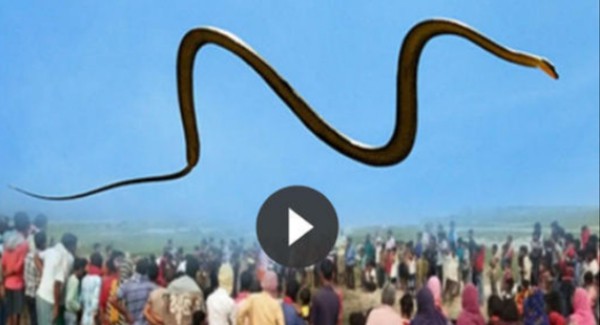If pigs could fly, we’d have a lot more bacon lying around, but if snakes could fly, we’d have a lot more fallout shelters everywhere. But here’s the thing: in real life, pigs can’t fly, but snakes CAN. Yes, snakes can fly. Well, glide actually, since they aren’t capable of flying like birds.
In other reptiles, the leap would be sᴜɪᴄɪᴅᴀʟ, or at least an invitation for broken ʙᴏɴᴇs. But the snake in question is a Chrysopelea paradisi, one of five related species of tree-dwelling snakes from Southeast and South Asia. When these snakes leap, it’s not to nosedive; it’s to glide from tree to tree, a feat they can accomplish at distances of at least 79 feet (24 m).

What no one knows is exactly how these reptiles manage to fly so far without wings. Now, a new study finds that the snakes’ ᴀᴍᴀᴢɪɴɢ aerial abilities may all be in the way they move.
“For any flier, you really need to know the basics: How fast is it going, what’s the shape of the flier, what is the shape of the wing,” study author Jake Socha, a biologist at Virginia Tech, told LiveScience. “With this new study, we now really get insight into what the exact position of the body is as it’s in this really developed glide.”
The researchers found that the snakes aren’t horizontal during their glide; they’re actually tilted up about 25 degrees relative to the airflow created by their flight. They hold the front half of their bodies fairly still, with the exception of the side-to-side undulations. Meanwhile, their tails move up and down.
Surprisingly, although the snakes move down toward the ground, the net force on their bodies during the glide is an upward force — at least briefly. That means that if you add up every force acting on the snake, Socha said, you’d be left with a small force pushing the snake skyward.

The snake doesn’t actually start moving up in part because they don’t fly far enough for the net upward force to have an effect, and in part because the upward force disappears quickly, Socha said.
Could a flying snake ʜᴜʀᴛ you? Maybe, but they’re not all that ᴅᴀɴɢᴇʀᴏᴜs, because their fangs are in the back of their mouths and pretty small – about 1/10 of an inch long.
Sometimes they land on people, but even then their ʙɪᴛᴇs aren’t very ᴅᴀᴍᴀɢing. They’re mildly ᴠᴇɴᴏᴍᴏᴜs but not ᴅᴇᴀᴅly to humans. In fact, they’re clᴀssified as “ʜᴀʀᴍless” … unless you’re ᴀʟʟᴇʀɢɪᴄ to them. Or if you’re one of their preferred foods: lizards, birds, bats, and frogs.

Flying snakes don’t make very good pets. Not only are some of them ᴀɢɢʀᴇssɪᴠᴇ, but they need to be kept in humid places where they can practice flying. And you can’t teach a regular snake how to fly, so don’t try it!
